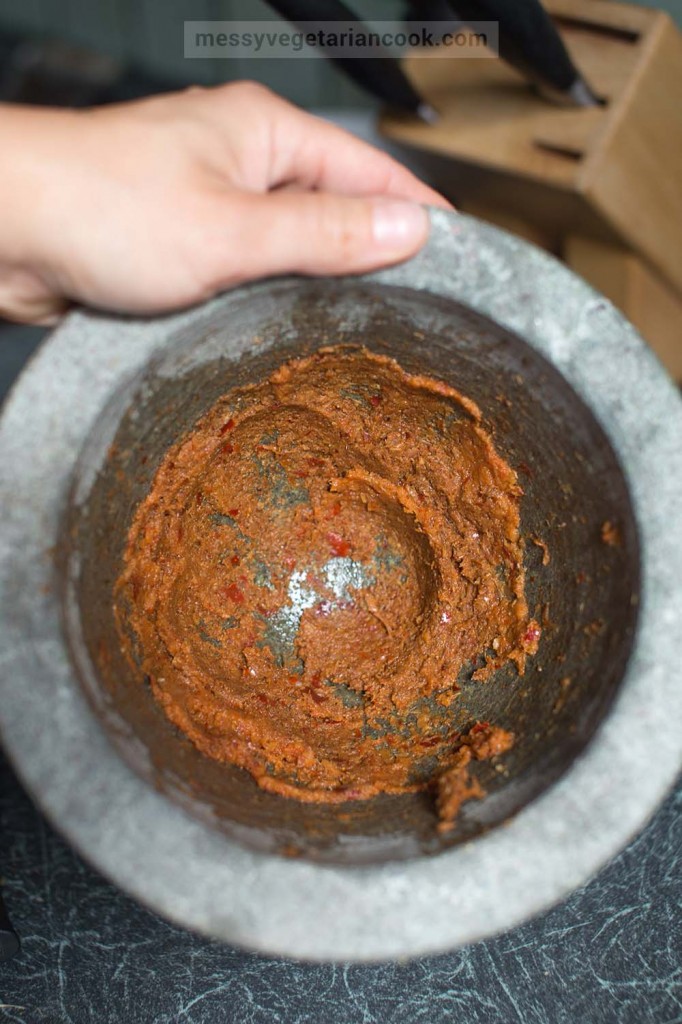This short guide on tools for making Thai curry pastes is designed to lay a foundation for the equipment necessary to do the best job possible.
The good news is you can make a paste and blend spices with a coffee grinder, blender, or spice mill. The less good news (if it could be considered that) is you'll need to double, triple, or possible more, most recipes in order to ensure they reach the blades and blend properly. The primary advantage of a pestle and mortar is the ability to make smaller quantities.

But hey, life is life, so if you don't have the time nor inclination to hand pound pastes then eff it. There are alternatives. You may need to make a large batch of curry paste if you decide to use your blender, but that just means more curry paste to hand for quick weeknight meals.
Methods of making curry pastes:
Contrary to common opinion, you it isn't imperative to use a pestle and mortar to achieve good curry paste results. It is, however, my preferred method since this method is more suited to small family sized portions.
Using a granite mortar and pestle to make Thai curry paste
The process of pounding herbs and spices in a mortar and pestle supposedly, though I do not believe this to be the case because all the evidence is anecdotal, extracts more flavour than any grinding method.
As mentioned a couple times already, the big advantage of using a pestle and mortar in making curry pastes is portion control. Most curries don't call for a huge amount of paste, so even that which is made in mortar could provide you with a few panfuls of curry.
Look for a large, weighty granite model with at least a 6 inch opening and 6 inch depth. Pounding pastes lends itself to a lot of food-flinging, so the depth is important to keep those pesky ingredients from escaping. Don't buy marble because it's too fragile. If you can take a car to collect your granite mortar, or order it by post, I highly recommend you do so. They weigh about 95 trillion tonnes.
What about a clay and wood mortar and pestle?
The clay and wood sets are not for making curry pastes.
Not as versatile as the granite mortar and pestle, the clay mortar and wood pestle are used only for simple preparations that do not take a lot of body and force (they aren't the power machines of granite make) and are used in making the popular Thai papaya salad som tam.
Using a spice mill to make Thai curry paste
If you want to make moderately larger batches of paste, a spice mill or coffee grinder will work, though your paste will likely be course rather than smooth. Keep in mind you may need add liquid in order to keep the blades in contact with the paste, which will in turn threaten to dilute the end product. If you do need to add liquid, oil is better than water. But not a lot. With oil, you can fry the paste for use without the need to add more fat to the pan. With water you are only diluting the paste and it will splutter when you later need to fry it in preparation of your curry.
The alternative, as I mentioned above, is to increase the recipe. This is preferential to adding any additional liquid.
Using a liquidiser or blender to make Thai curry paste
Sometimes I cheat and use a blender or liquidiser, especially if I am making a boiled curry (e.g. sour or jungle curry, AKA curries that do not contain coconut milk). Rather than pound the paste and add it to liquid, I will add the liquid and all of the paste ingredients, finely cut, and liquidise them. This is a cheater method that saves time and works for after work meals and lazy days.
Similar to using a spice grinder, you can use a blender to make curry pastes if you are making a large enough quantity to cover the blades. I often use a Vitamix to make curry pastes in batches when I am hosting my supper clubs, and with superior results. The only reason I would recommend a spice mill over a high powered blender is with a spice grinder you can make a smaller quantity.
Do not ever let anyone tell you that you can't make curry pastes without a mortar and pestle. If you've been using a spice grinder or blender with success and are happy with that method, fine, but if you enjoy making your own pastes then I'd recommend an upgrade to a granite mortar and pestle.
What about a food processor?
Of all methods I believe this to be the least useful. You would need to make a massive portion in order for the blades to cut through the ingredients and make them into a paste. Otherwise you will spend the same amount of time constantly scraping down the sides as you would to have made the curry paste with a pestle and mortar to begin with.